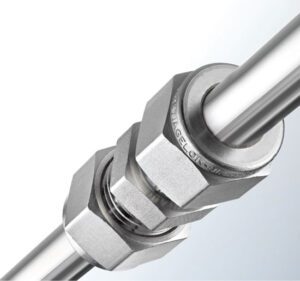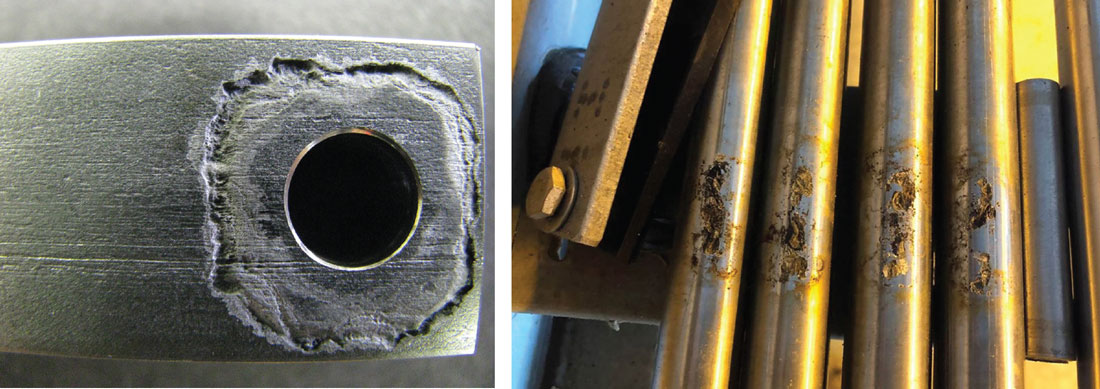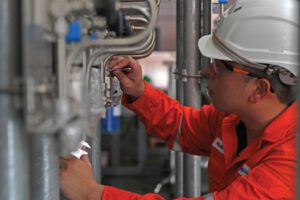Offshore oil and gas platform and floating vessel owners must optimize costs. But more importantly, they must maintain safe and compliant operating conditions for employees over the life span of their operations. Choosing the proper materials when designing the fluid systems in these specialized applications combines these important goals.
By Gary Matson, Product Line Leader, Swagelok Company. Images © 2022 Swagelok Company
For example, 316 stainless steel (SS) tubing and tube fittings provide excellent corrosion resistance while remaining economical in many platform applications. When the applications are more challenging, they require more robust alloys like super austenitic 6-moly or super duplex 2507. These alloys provide better corrosion resistance than 316 SS but come with higher upfront costs.
Operators may be tempted to require the higher-cost alloys for all applications because offshore environments can pose more significant challenges than others. By specifying more expensive alloys, even in situations where it is not necessary, the cost increases are substantial because of the miles of tubing and thousands of fittings required in offshore fluid systems.
In addition, designers commonly believe that tubing materials must match those of the tube fittings, but that is not necessarily true. In fact, it is possible to use two different, but compatible, materials to resist galvanic corrosion. Specific combinations of 316 stainless steel and more robust alloys (Figure 1) can help to ensure the safety of offshore operations while keeping overall system costs down.
Before deciding which components to use in offshore fluid systems, operators must understand the specific corrosion threat to their application. Once they’ve identified the problem, they can use materials science to select the proper component for their project.
Understanding the corrosion threat
Different forms of corrosion affect tubing and tube fittings in specific ways, whether they are used on chemical injection skids, hydraulic power units, topside umbilical terminations, wellhead control panels, or other applications. In particular, tube fittings are susceptible to stress corrosion cracking, while tubing is more prone to pitting and crevice corrosion. Corrosion of either sort can cause tubing or tube fitting failures, which could lead to a potentially hazardous leak.
Pitting and crevice corrosion in tubing

For pitting and crevice corrosion to occur, chlorides like those frequently found in saltwater attack the tubing surface in areas where the metal’s protective, chromium-rich oxide layer is present. Pitting corrosion (Figure 2) and crevice corrosion (Figure 3) are similar phenomena.
Pitting appears as small cavities on the tubing surface, also known as pits. When the protective layer of oxide (or passive oxide layer) on the surface of the metal breaks down, the metal becomes susceptible to loss of electrons. This causes iron in the metal to dissolve into a solution in the more anodic bottom of the pit, diffuse toward the top, and oxidize to iron oxide, or rust. The iron chloride solution concentration in a pit can increase and become more acidic as the pit gets deeper. These changes result in the accelerated growth of the pit, perforation of tubing walls, and leaks. Crevice corrosion most often occurs in the tight crevices between tubing and tube clamps. Like pitting corrosion, crevice corrosion starts with the breakdown of the passive oxide layer that protects the metal. This breakdown leads to the formation of small pits. The pits grow larger and deeper until they cover the whole crevice. In some places, tubing can even become perforated. Crevice corrosion occurs at far lower temperatures than pitting corrosion. Crevice corrosion may also occur underneath dirt and deposits on tube surfaces or between adjacent tubing runs.
Using robust materials with higher critical pitting temperatures (CPTs) and critical crevice corrosion temperatures (CCCTs) – such as 6-moly alloys 254 or 6HN (UNS N08367), super duplex alloy 2507, or nickel alloys 825, 625, C-276, or 400 – is a good defense against these common corrosion threats. Plastic clamps that allow drainage of liquids may also be used to help mitigate crevice corrosion.


Chloride stress corrosion cracking (CSCC) in tube fittings

High-chloride environments where tube fittings are under significant tensile stress contribute to CSCC, particularly when lower-grade tube fittings are used (Figure 4). Stress cracks on the fitting nut occur when the stress on the fitting assembly and the system pressurization become too much for the tube fittings to bear. Under high-chloride conditions, small cracks can branch and expand, which could eventually cause the nut to crack unexpectedly.
The solution to this problem can be as simple as using more robust alloys, similar to those used to prevent pitting and crevice corrosion – but this can significantly increase the cost of the system. In contrast, a high-quality 316 SS formulated with elevated nickel (12% minimum) and chromium (17% minimum) contents can handle CSCC just as effectively in mildly or moderately corrosive environments. By exceeding the minimum requirements of the applicable ASTM standards, this solution not only maintains the safety of the system but saves money in the long run.
Optimizing your specification

A full understanding of the different types of corrosion affecting tubes and tube fittings leads to one simple conclusion: pairing high-quality 316 SS tube fittings with robust alloy tubing can produce reliable, cost-optimized corrosion control and improve the system’s overall safety.
In addition to paying attention to the metal makeup of the fittings, it is important to think about other qualities the tube fittings should have. The fittings should have hardened ferrules to create a leak-tight seal and resist environmental vibrations. Work with your supplier to secure the test reports of your tube and fitting combination and ask them what quality controls they use in the manufacturing process to ensure quality and performance in real applications.
Finally, keep in mind the importance of proper installation methods. Even if your materials have been optimized, poor installation can negatively impact performance. Ensure your platform technicians know how to properly handle tubing, and assemble tube fittings to ensure reliable, leak-tight operation (Figure 5). Your supplier may be able to offer training opportunities to enhance the knowledge of your personnel.
Ultimately, selecting an engineered combination of materials for platform fluid systems will depend on your operating and environmental conditions, your preferences, risk tolerance, and budget. There are a variety of operating environments in which the opportunity to save cost on your connections can be done safely with the right supplier.
An original version of this article appeared on the Swagelok Reference Point blog here: www.swagelok.com/en/blog/offshore-safety-savings-engineered-combinations.
About this Featured Story
This Featured Story appeared in Stainless Steel World October 2022 magazine. To read many more articles like these on an (almost) monthly basis, subscribe to our magazine (available in print and digital format – SUBSCRIPTIONS TO OUR DIGITAL VERSION ARE NOW FREE) .
Want to contribute as author? Please contact Joanne.
Every week we share a new Featured Story with our Stainless Steel community. Join us and let’s share your Featured Story on Stainless Steel World online and in print.


